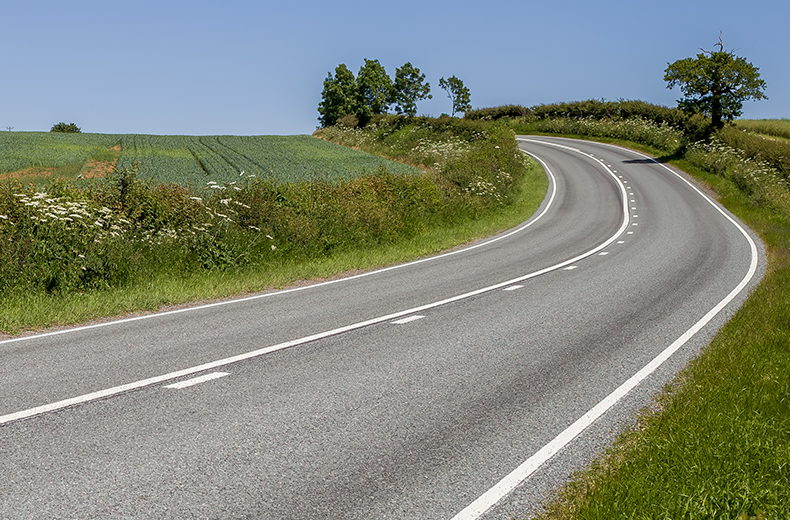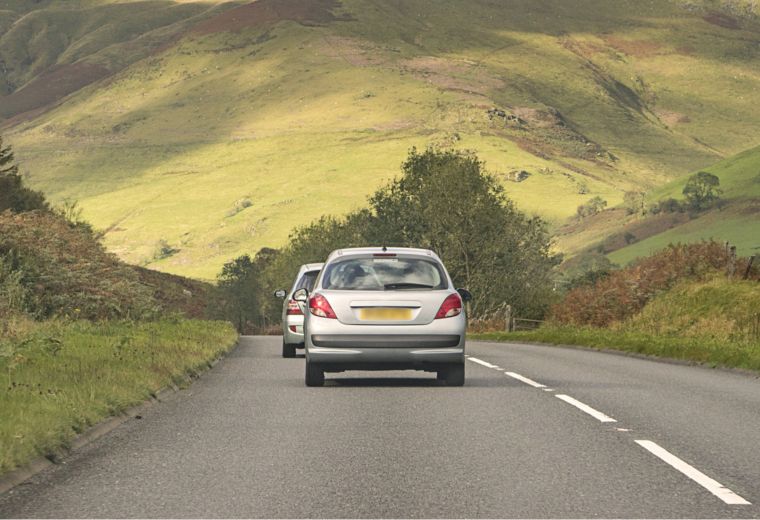Overtaking on single-lane roads can be daunting for newly qualified drivers – even some established ones – but it’s an important manoeuvre to master safely and confidently.
What is overtaking?
Overtaking is passing another slower moving road user that’s travelling in the same direction as you.
This is usually another vehicle, but could also be a cyclist, horse or other road user.
Is overtaking on a single-lane road illegal?
It is illegal if there are signs or road markings clearly prohibiting it, or if it’s done in an unsafe, reckless or uncontrolled way.
Examples of this include when you don’t have clear visibility of the road ahead – maybe in poor weather, such as rain or fog – or if you must break the speed limit in order to overtake.
Can you speed to overtake?
As rule 125 of the Highway Code states, the speed limit is the absolute maximum you should drive on any particular road. This does not exclude overtaking.
Exceeding the speed limit for any reason is dangerous as well as illegal and could see you hit with penalty points, a hefty fine, or even being banned from the roads entirely.
While overtaking is, of course, legal, there are strict rules about how and when it is safe to overtake – the most fundamental being that you should only overtake ‘when it is safe and legal to do so’.
If you’re caught speeding while overtaking, you could collect a fine up to £2,500 and six points on your licence, depending on your speed and the road you’re caught on.
- 10 driving offences you didn’t know were illegal
- Speed cameras – how they work
- Did you know that we offer specialist learner driver insurance?

RAC Breakdown Cover
Limited time offer.
*£7 a month for new, single vehicle Basic cover. ^For all named members when added to new Extra or Complete cover. Included in Family cover as standard. Excludes Basic cover. Ends 08/05/24, 7am.

The rules for overtaking safely
When overtaking on a single-lane road it’s important to follow these steps:
- Consider if it’s necessary. You may feel frustrated being stuck behind someone driving slowly and holding up your journey, but if you’re getting off that road soon anyway, is it worth the risk? How much time will you really save?
- Ask if it’s safe to overtake. Are there ‘no overtaking’ signs in the road? Are there any hazards ahead such as pedestrian crossings or a junction? Are you coming up to a bend or is there a dip in the road obscuring your vision? Never try to overtake unless you have clear visibility of both lanes of the road ahead.
- Check both lanes. Do you have a clear line of vision? Will there be enough space (around 100 metres) ahead after overtaking? Remember, you’ll not only need enough space to speed up to overtake, but also space to pass the car in front and cross back over in front without causing them to slow down.
- Keep in mind your car’s performance. Are you used to normally driving by yourself, but today you have passengers and luggage in the boot? Or is the road uphill?
- Do not assume you can follow another car that’s overtaking ahead of you. They may have judged that there’s enough room for them to overtake, but there may not be for you too. Plus, you won’t necessarily have clear visibility of the road when following another car.
- Check your mirrors. Make sure the road is clear – not just ahead of you in the oncoming lane, but also behind you and in your blind spot – there may be a car or motorcycle about to overtake you that you don’t initially see.
- Drop back slightly and signal. This will give you acceleration space while indicating to the car in front of you (or any behind you) that you’re about to overtake.
- Keep checking the road and your mirrors. If there’s an unexpected hazard, you’ll need to drop back quickly and safely.
- Accelerate assertively. Make sure to overtake quickly and in a controlled, confident way.
- Don’t cut up the driver you’ve overtaken. As a rule of thumb, don’t start to pull back across into your lane until you can see the entire overtaken car in your central rear-view mirror. Then smoothly pull back in and don’t stop accelerating until it’s safe to ease into your normal speed.
Can I overtake more than one car?
You must only do this if it is safe to do so and under certain conditions:
- The opposite side of the road is sufficiently clear to safely overtake
- There‘s a suitable gap in front of the vehicles you plan to overtake
- You have a clear view ahead of you
- A road user behind isn’t attempting to overtake you
When should I not overtake?
You should not overtake on a single-lane road in these circumstances:
- In poor weather conditions: such as rain or fog where you are unable to safely see the road in front of you.
- When you don’t have clear visibility of the road: such as on a bend, a hump bridge, or on the brow of a hill.
- When the road markings forbid it: you may think it’s safe, but there may be a hidden hazard you’re unaware of.
- Approaching a potential hazard: such as roadworks, a junction, school crossing, level crossing or a narrowing of the road ahead.
- If the vehicle in front of you is indicating right: even if their positioning in the road implies they’re not turning.
Can I overtake if there’s double white lines?

It is illegal to overtake if there are road signs or markings prohibiting it. These road markings appear as variations on double white lines; where the line nearest to you is broken, where the line nearest to you is solid, or where both lines are solid.
Double white lines where the nearest line is broken
Rule 128 of the Highway Code says you may cross these lines to overtake if it is safe and you can complete the manoeuvre before reaching a solid white line on your side.
Double white lines where the nearest line is solid
Rule 129 of the Highway Code says you must not cross or straddle these lines unless it is safe and you need to enter adjoining premises or a side road.
There is one exception however; you may cross the line to pass a stationary vehicle, or overtake a pedal cycle, horse or road maintenance vehicle, if they are travelling at 10 mph (16 km/h) or less.
Double white lines where both are solid
These are used to prohibit drivers from travelling in an area of the road used by the opposing flow of traffic, generally where overtaking visibility is restricted.
You must not overtake if it means crossing or straddling these double solid lines.


How should I overtake a horse rider?
You can overtake a horse rider but do so at a much lower speed. Give them as much room as you safely can – ideally more than you would a car. Turn down the volume on your radio, do not rev your engine, honk your horn or speed up quickly behind them - as these are all things that could easily spook the horse and cause an accident.
Make sure to also keep watch out for signals from the rider to slow down or stop.
How should I overtake a cyclist?
As with horse riders (and motorcyclists), make sure to give at least the same room as you would do car. As with all overtaking manoeuvres make sure to only attempt when it’s safe to do so and clearly indicate your intentions.
Get 30 driving tips that will save you money
Running a car isn’t cheap, but there are some easy things you can do to keep your costs down. Get these tips and more useful driving articles sent straight to your inbox now.

















